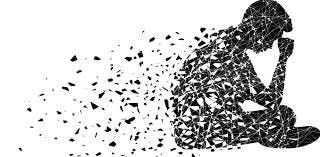What's Happening to Young People's Mental Health?
Here’s the latest from Practicing Mental Illness:
There has been a lot of concern about how the stress of Covid-19, the economic shutdown and debates about social justice in 2020 will affect people’s mental health. But the mental health of people under 25 has been deteriorating for over a decade.
Not including this year of crisis, rates of psychological distress, major depression and suicidal ideation have not increased significantly over the last 10 years for middle-aged and older adults (incidence of mental illness has even declined in adults over 65), adolescents and young adults have seen huge increases in mental illness.
Research published in the Journal of Abnormal Psychiatry finds that, from 2005 – 2017, the rate of major depression in tweens and teenagers increased 52%. It’s up 63% in young adults aged 18 – 25. 13.1% of adolescents and young adults reported psychological distress in the previous 30 days, up from 7.7% in 2008, and 47% more young people are having suicidal thoughts.
There seems to be a fundamental change in the incidence and experience of mood disorders. This especially concerns me because I have a 10 year-old daughter who’s already experiencing a range of moods and emotions that I didn’t encounter until I was much older.
When something like mental illness increases at such alarming rates, it’s necessary to examine things that are different in the surveyed population than in other age groups. Of course, the obvious and usual suspect is technology. But other generations use social media and game online and don’t experience increasing mental health challenges. So things must be more complicated.
My daughter would spend all day on Tik Tok and Roblox if we let her. I wonder if her activity is really any different from my experience of shutting myself in my room and listening to records over and over when I was her age. It may not be. We old folks like to lament that our activities involved more imagination and less potential for bullying, but the researchers found the negative impact of technology is more basic. And, encouragingly, more easily adapted to and improved.
Kids are not set up for persistent poor mental health if they communicate in diverse ways, exercise and get enough sleep.
Use of technology can inhibit these things, but subtle changes in lifestyle and behavior can correct these negative effects and subsequently reverse the troubling trend in poor mental health. Better outcomes could be as simple as increasing opportunities for face-to-face interactions, putting devices down and moving around a bit, and not using devices within one hour of bedtime, and not sleeping, or trying to sleep, with the device in the bedroom.
We can debate the impact of technology on impulse control and immediate gratification, expression of ideas and patience, but all the while depression and other mental illnesses are taking a terrible toll on young people. Instead of being luddites and complaining about the ever present availability of information and connectivity, perhaps we can create opportunities for young people to personally interact, exercise and sleep.
The worst thing about remote learning and work in 2020 and into 2021 is that it reinforces these negative trends and makes corrective action more difficult. But we’ll get beyond this, and with simple little changes so can our young people.
Meditation for Teens
As incidence of mental illness increases in teens, meditation can help kids manage stress, gain perspective, avoid troubling rumination and sleep better. Getting started with a meditation practice can be difficult and sticking with it can be even more challenging. But people are more likely to keep at it if meditation shows benefits and fits in with their lifestyle.
Now I am no fan of meditation apps. To my Zen trained point of view they’re unnecessary and distracting. But teens are already using apps for most everything, so why not meditation. Why should my prejudice against this technology prohibit other people from trying it?
I don’t know much about the various meditation apps available today. But Teen Vogue does. They reviewed 10 of them here. If getting started with the silent, breath-focused practice I advocate is too daunting or unpleasant, certainly try one of these.
Mindfulness and Addiction
I don’t write a lot about addiction because I haven’t experienced it. My posts usually refer to and rely on some personal experience, and when it comes to substance abuse and addiction I don’t really know what I’m talking about. But Dave Smith does. He also knows more about mindfulness practices, early Buddhism and recovery then anyone I know. And he comes to his practice, and his teaching, through all the despair and hope of lived experience.
In-person teaching has been impossible this year, and likely won’t be starting anytime soon. This is tragic because recovery benefits from the bonds forged between people walking the path together. To help re-establish this connection Dave has launched the Buddhist Recovery Online Class and Community. If you struggle with substance abuse please check it out.




